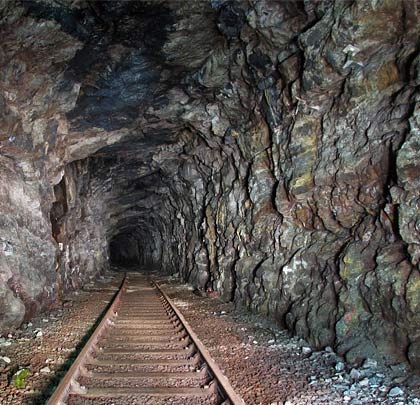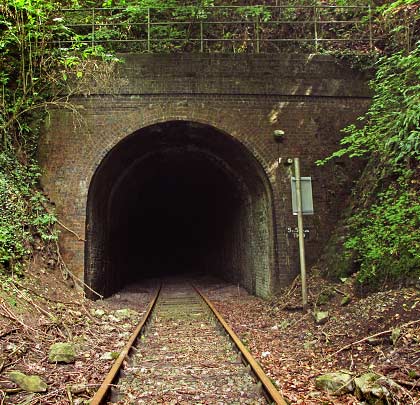Tytherington Tunnel
Tytherington Tunnel


















The Midland Railway opened its 7½-mile branch from Yate to Thornbury in stages, completing it in September 1872. The line had opened to Tytherington in 1869 but the intervening 2¼ miles required a pair of tunnels to be engineered, totalling 391 yards. The longer of these, at 224 yards, was found 5 miles and 46 chains from the start of the branch and a stone’s throw from the station at Tytherington, which gave its name to it.
Climbing a challenging 1:59 gradient, trains encountered the unassuming east portal as the single track curved southwards on a radius of 39 chains. Built in brick and colonised by ivy, it features four square pattress plates around the crown of the arch. The lining, comprising four brick rings and vertical sidewalls, only extends for about 10 yards; thereafter the tunnel shows off the rock through which it was driven.
Towards the middle is a single ventilation shaft. This was reduced in height and capped with an unusual brick dome when the M5 motorway was constructed across the tunnel in 1970-71. The railway had closed to passengers during the Second World War and goods in September 1967. A final train ran two months later, after which the track was quickly lifted. However in July 1972, the route was reopened as far as Grovesend Quarry, immediately west of the tunnel. This operational period ended in 2012 with the quarry’s closure, although there have subsequently been calls to reopen the line to serve the sizeable town of Thornbury.
The tunnel is mostly dry but some accumulations of calcite are apparent around the shaft’s eye. Elsewhere, several rock bolts have been inserted as a precautionary measure, preventing material from falling onto the track which is still extant. Chainage tablets are fixed to the sidewalls.
The curve gives way to a straight section towards the west end, before the tunnel turns northwards on a radius of 41 chains. Its western portal – topped with a hand rail – is a mirror of its sibling but has escaped the clutches of ivy growth.







